Library Ramblings: Genrefication – one year on
A year ago, our school library transformed our Young Adult collection. Using a variety of new genre stickers, genre groupings and collection changes, we fully embraced the genrefication process for our fiction collection. One year on, I took the time to investigate how the change effected our library, borrowing statistics, usage of the collection and student feedback, and how this reflection would direct our future practice. Here is what I learnt, my successes, what I could have done better and my thoughts on the overall process.
The Story – The Results – The Interpretation – The Implications – Positives and Negatives – Overall
The Story

Mid-way through our genrefication process.
When we started the move towards genrefication, we felt collaboration between all library staff and the students would be key to ensuring this process would be successful. You can read about our process in my Ramblings: Genrefication post. We had undertaken this move due to a strong push in the library sector towards genrefication and felt it would be a way to freshen our collection. We also hoped it would help struggling or reluctant readers to more easily find the books that might captivate them. Overall, our goal was to increase reader engagement with the collection, books and reading, to be measured in borrower statistics and feedback from students.
The genrefication process was undertaken at the end of the school year, just before the library was closed for the summer holiday break. Throughout the following year, the collection arrangement was altered slightly as needed. For example, while we had previously used Diary genre stickers, having a separate collection for these titles was not suitable, and so these books were relabelled and absorbed into larger collections. We also had to continually reshuffle the arrangement of the collection to ensure adequate space. Due to the large number of titles in our collection and the extra space needed for the genre layout, many of the display shelves were needed to be used for shelved books. Towards the end of the year, after stocktaking the collection, the collection was thoroughly weeded. Reports were then produced for discussion and reflection on the year’s borrowing and how the genrefication process might have impacted borrowing.
The Results
Simply put, after genrefying our Young Adult collection, our borrowing statistics fell dramatically. Annually, our YA collection would consistently average 1400 loans – this has been the same throughout the last six years. The year after genrefying, our loans dropped to 800. I was honestly shocked by the result. Other school libraries had reported great success after genrefying their collection. The process was meant to increase borrowing, not almost halve it. It was time for a deeper analysis.
Looking at the results in a month-by-month analysis, the first 6 months of the borrowing year had significantly reduced borrowing statistics compared to previous years. Where we might have previously averaged 100-130 loans in March, we instead only loaned 20. However, in the last six months of borrowing, the number of loans increased and even surpassed previous years’ averages for each month.
From this I can only interpret that the initial move confused students. Once the new arrangement become more familiar, engagement increased again and borrowing statistics reflect and increase compared to previous years’ averages.
Feedback from students has been mixed. Conversations with our regular readers has reported mostly positive feedback, saying it is easy to find the books they like and fun to browse within a particular genre. Other students have passed on negative feedback, saying they find it hard to locate books, especially when they only know the author’s name or are not sure what genre the book would fall under. Unfamiliarity with using the OPACs would compound this. From my perspective, it is certainly easier to make book recommendations and helpful when classes or readers are needing books from a particular genre, e.g. speculative fiction.
There are a number of other reports I would like to run, comparing the size of the collection to the loans and number of borrowed titles rather than just loan statistics. I also still need to assess the statistics of each collection – which are the most popular genres, which the least used?
The interpretation
There are a number of factors outside the genrefication of the Young Adult collection that could have contributed to our reduced loan statistics. Slightly reduced use of the space by English classes for reading lessons (this relies solely on the teacher’s interest and valuing of these reading times) and verbal feedback from students saying they are just too busy with school work for reading these days might have contributed.
The collection had also grown significantly over the past few years and was very quickly expanding past the available shelf space. This meant a lack of display areas and crammed shelves. Verbal feedback from students and research has indicated the importance of covers in their choice of titles and ‘impulse loans’, so this could have impacted student borrowing.
However, we believe that unfamiliarity with the new arrangement of the collection was primarily to blame. Librarians reported that students had provided feedback indicating their confusion with the change, something that could account for the reduction in loans in the six months following the change and the increase in loans after this time. Further, it is important to note that our library does not regularly provide teacher-librarian directed lessons, so, there was no opportunity to familiarise classes of students with the new arrangement, aside from signage and informal conversations with students already browsing the collection.
The implications
Something needed to change. Our Head of Library Services collaborated with the head of the English department to discuss usage of the space during English classes, and increase reader advisory sessions at the beginning of the year to promote the space and reading. My focus was change within the collection space itself.
First step: Weeding and moving
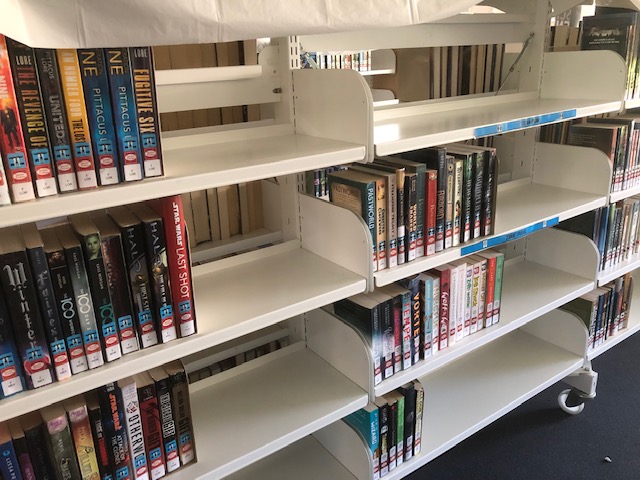
Shelves freshly weeded and ready for plenty of books on display.
My first step was undertaking a very thorough cull of the collection, removing titles that had not been used recently, had lost their relevancy and/or were no longer appealing to students. Fortunately, we have a large library and a very supportive head of library services who likes change and so she facilitated a large reshuffle of the library’s collection which meant that the Young Adult collection could be now be spread over 3 large bays of shelving rather than the previous two. This increase in space meant I could allocate a large number of devoted display shelves, new book display areas, and plenty of space on each shelf itself – no more squished spines. However, this move does mean that students are once again faced with confusion over the location of the titles they seek. For example, after the move one student was staring blankly at the shelves. When I asked if I could help, she could indicate the general synopsis of the book, but not the genre, author or title (not even the colour of the book.) Using her description and working from the location she remember and where I had moved those titles, we found the book she was looking for, but it reinforced the importance of location rather than signage or book details.
Step Two: iNCREAsed Signage
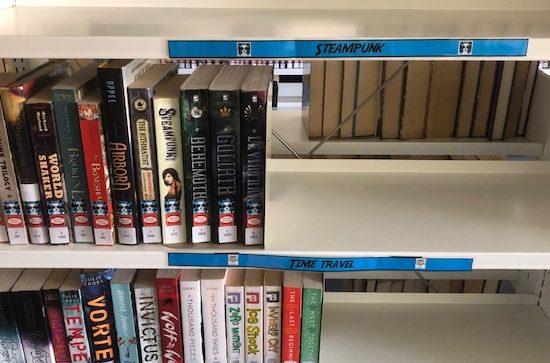
Colour-coded shelf labels
While the collection had previously employed long, coloured labels that ran across the edge of all shelves indicating the genre collection, as well as end panel signs indicating the layout of the collection, more signage was clearly needed.
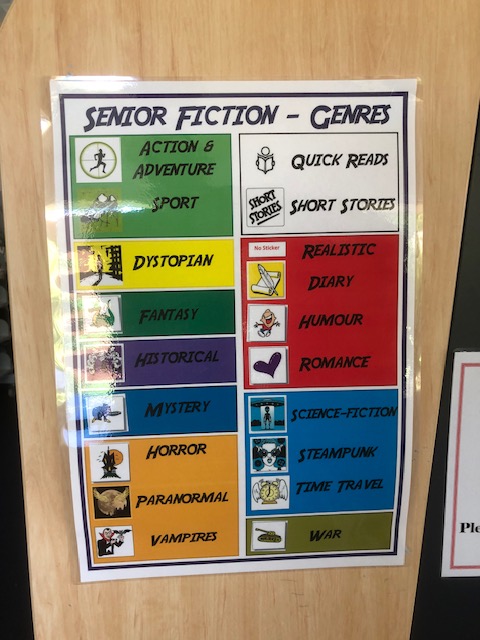
Old end-panel sign with genre groups.
Each genre collection or grouping of genre collection has been colour coordinated. For example, horror, paranormal and vampires are located together in the orange section. I made signs to stand at the start of each collection, describing the genre and listing some popular titles.
I also revamped the end panel sign, breaking down the collections grouped within each shelving bay. I am also hoping to utilise our library management system’s map feature, for easy location of titles from the OPACs. We are also purchasing acrylic shelf dividers and adhesive vinyl to create custom shelf signs for the start of each genre collection.
Step Three: Promote
The Young Adult collection is going to be the focus of many displays and library activities this year. My plans include:
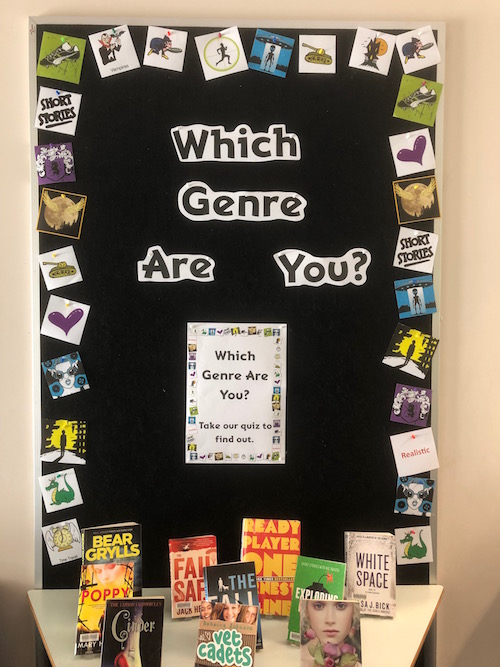 Reader advisory and orientation sessions with English classes
Reader advisory and orientation sessions with English classes- An interactive genre labyrinth-quiz.
- Weekly themed displays on designated display shelves within the collection. Some examples include summer reading, If You Liked…Try, Seen the Movie Try…, books for rebels, as well as particular genre features.
- Shelf talkers
- Revitalising and releasing genre bookmarks and posters
- Additional signage, including maps
- Using the library’s electronic displays to promote books by genre
- General library activities and displays to feature genres. For example, my Wheel of Reading
- Information sheets on how to best use the collection and inclusion of genre layout in orientation booklets.
Positives and Negatives
+ Collection is easy to use (for librarians and students who are familiar with the collection).
+ Easy to assess collection and improve collection management, expanding collection in genres that need development and monitoring the usage of our largest collections.
– Can be confusing for students unfamiliar with genre or collection layout.
– Takes up more shelve space and so collection needs to be reduced or spread additional shelf.
Overall
Would I genrefy again? Yes. While the initial stats weren’t positive, I think overall the effect is positive, with many benefits. However, I have learnt about the very great importance of easing students into change and how, without explicit instruction, this change can be overwhelming and off-putting. I look forward to continuing to actively promote our genrefied collection, and continuing to monitor and report on the collection. I hope that in another year’s time our borrowing statistics will reflect our intended goals, but in the meantime, with reflection and ongoing critical practice, we can continue to monitor and adjust our practice to ensure our readers and their needs are being best served.
However, I would note here that I would not genrefy our Junior fiction collection (for readers aged 6 to 11), especially as we do not have a teacher librarian taking library lessons through whom such a change could be actively explained and taught to students.
Update: Another term on
While I will complete a full post at the end of the year (two years on), this is a quick update about what has been achieved in the first term of this year.
Reader Advisory lessons.
Collaboration between the English department, the Head of Library Services and myself has led to short reader advisory sessions for any English classes interested (again, relies on English teacher engagement.) The response has been overwhelmingly positive. What a powerful tool a short, fun and engaging conversation about our collection layout and great books is.
Genre Quiz, and Displays
Fun and interactive displays has increased engagement with the collection.
Shelf Space and Covers are Key
More space for displays and forward-facing books has a huge impact. Books on display quickly need to be replaced.
oVERALL sTATS
Verbal feedback has been overwhelmingly positive about the changes we have made. The borrowing statistics reflect this. Previously, while February might have averaged 200 loans, we achieved over 400 loans this year. Term 1 statistics have more than doubled for our YA collection. So, does genrefication work? Yes, but not without huge promotion. The key factors for student engagement with reading and literature is face-to-face interaction, promotions, and teacher-librarian led sessions. You can change the layout of the collection and that can be helpful for a variety of reasons, but the power really lies in people.
Further Reading
I found Susan Davenport’s article, Genrefying the Fiction Collection in SCIS Connections very helpful.
Hennah, K. (n.d.). Library Experience. http://www.kevinhennah.com.au/a-few-of-kevins-thoughts/
Kneebone, L. (2016). Architecture of genre. Connections, 96. Retrieved from:http://www2.curriculum.edu.au/scis/connections/issue_96/articles/architecture_of_genre.html
Moyer, J. E. (2005). A literature review of readers’ advisory services, adult fiction librarianship, and fiction readers. Reference & User Services Quarterly, 44(3), 220-26, 229-231. Retrieved from http://ezproxy.slq.qld.gov.au
Pendergrass, D. J. (2013). Dewey or don’t we? Knowledge Quest, 42(2), 56-59. Retrieved from http://ezproxy.slq.qld.gov.au
Shearer, K. (ed.) (1996). Guiding the Reader to the Next Book. New York: Neal Schuman.
Sweeney, S. (2013). Genrefy your library: Improve readers’ advisory and data-driven decision making. Young Adult Library Services, 11(4), 41-45. Retrieved fromhttp://ezproxy.slq.qld.gov.au
Whitehead, T. (2016). 5 Steps to Ditching Dewey: Genrefication in Your School Library. Retrieved from http://ideas.demco.com/blog/5-steps-to-ditching-dewey-genrefication-in-your-school-library/
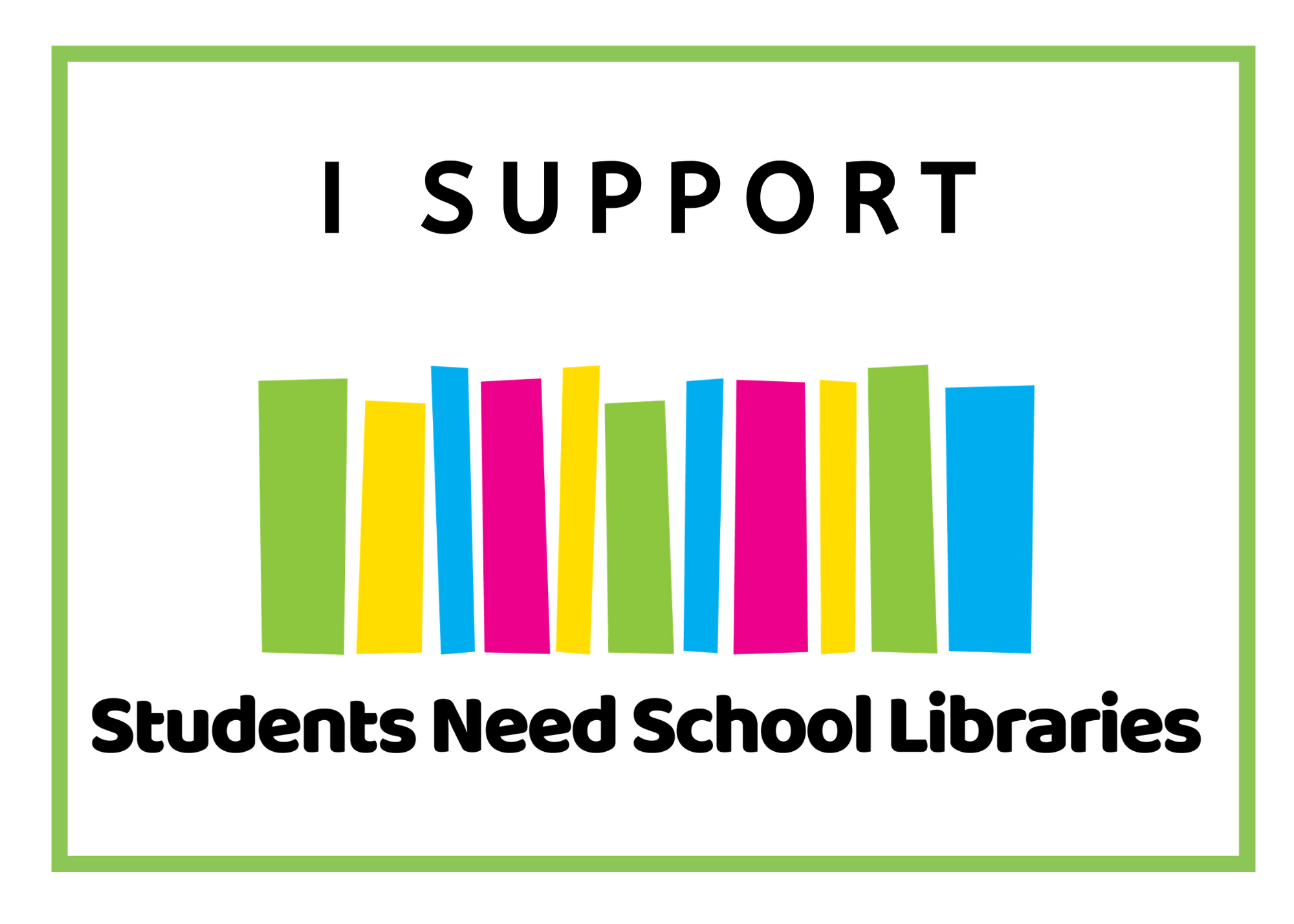

Leave a Reply